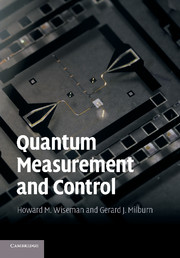Book contents
- Frontmatter
- Contents
- Preface
- 1 Quantum measurement theory
- 2 Quantum parameter estimation
- 3 Open quantum systems
- 4 Quantum trajectories
- 5 Quantum feedback control
- 6 State-based quantum feedback control
- 7 Applications to quantum information processing
- Appendix A Quantum mechanics and phase-space
- Appendix B Stochastic differential equations
- References
- Index
6 - State-based quantum feedback control
Published online by Cambridge University Press: 17 February 2011
- Frontmatter
- Contents
- Preface
- 1 Quantum measurement theory
- 2 Quantum parameter estimation
- 3 Open quantum systems
- 4 Quantum trajectories
- 5 Quantum feedback control
- 6 State-based quantum feedback control
- 7 Applications to quantum information processing
- Appendix A Quantum mechanics and phase-space
- Appendix B Stochastic differential equations
- References
- Index
Summary
Introduction
In the preceding chapter we introduced quantum feedback control, devoting most space to the continuous feedback control of a localized quantum system. That is, we considered feeding back the current resulting from the monitoring of that system to control a parameter in the system Hamiltonian. We described feedback both in terms of Heisenberg-picture operator equations and in terms of the stochastic evolution of the conditional state. The former formulation was analytically solvable for linear systems. However, the latter could also be solved analytically for simple linear systems, and had the advantage of giving an explanation for how well the feedback could perform.
In this chapter we develop further the theory of quantum feedback control using the conditional state. The state can be used not only as a basis for understanding feedback, but also as the basis for the feedback itself. This is a simple but elegant idea. The conditional state is, by definition, the observer's knowledge about the system. In order to control the system optimally, the observer should use this knowledge. Of course a very similar idea was discussed in Section 2.5 in the context of adaptive measurements. There, one's joint knowledge of a quantum system and a classical parameter was used to choose future measurements so as to increase one's knowledge of the classical parameter. The distinction is that in this chapter we consider state-based feedback to control the quantum system itself.
This chapter is structured as follows. Section 6.2 introduces the idea of state-based feedback by discussing the first experimental implementation of a state-based feedback protocol to control a quantum state.
Information
- Type
- Chapter
- Information
- Quantum Measurement and Control , pp. 269 - 340Publisher: Cambridge University PressPrint publication year: 2009
